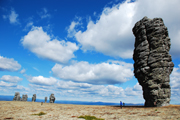Press release 2012-11-15 at 10:00
|
|

|
|
Photo: Jevgeni Izjurov
|
The unique nature in the northern parts of Finland, Sweden, Norway and Northwest Russia, i.e. in the Barents Region, belongs to one of the largest remaining natural state forest and tundra areas in the world. However, also untouched nature is threatened in many areas by the accelerating economic exploitation of natural resources by the forest, mining and oil industries, climate change. “Surveying and safeguarding the Barents Region’s ecological values should be urgently carried out to prevent complete loss of this northern natural environment”, says Senior Coordinator Anna Kuhmonen.
The Barents Protected Area Network (BPAN) project aims to assess the level and objectives of the conservation of the northern protected area network. The International Union for Conservation of Nature (IUCN) has drawn up a classification of protected areas that provides one point of view for comparison between the protected areas in the northern parts of Finland, Sweden, Norway and Northwest Russia. Experts from these four countries representing environmental administration, research institutes and environmental non-governmental organisations will assess the protected areas of the Barents Region at the BPAN seminar organised on Thursday 15 November in the Finnish Environment Institute, in Helsinki.
Large variations in the quality of protected areas
The objective and level of protection of the protected areas varies considerably in the Barents Region. In areas that are strictly protected, the diversity of habitats and species is safeguarded. However, in less stringently protected areas, only a specific species may be protected, and forest loggings or the mining industry may lower the state of the other parts of the ecosystem or even threaten the entire protected area and its ecological values.
The uniform classification enables creation of a comprehensive overview to be obtained of the strengths and weaknesses of the protected area network. This enables the compilation of consistent information across borders for decision-makers and authorities. "By producing unified and comparable information the objective is to improve discussion in decision making for developing the protected area network", says Leading Expert Tapio Lindholm.
”The IUCN categories system is a voluntary approach that provides a common language to describe the wide variety of protected area networks in different countries. BPAN is taking an important initiative that will help build collaboration between the four countries of the region”, says Nigel Dudley, editor of the IUCN Guidelines for Applying Protected Area Management Categories.
A continuous protected area network slows down the extinction of species
The aim of cross-border cooperation is support the conservation processes of the various countries and regions, as the challenges are similar. It is important for the environment as a whole how the separate protected areas are linked with each other. For example, many species must be able to migrate from one protected area to another to maintain viable populations.
The countries of the Barents Region have committed to the UN’s Convention on Biological Diversity (CBD), which aims to halt loss of biodiversity by 2020. One of the objectives of the Programme of Work on Protected Areas under the CBD is to establish a representative and effectively managed protected area network covering at least 17% of the world’s terrestrial areas and inland waters. The BPAN project aims to support the implementation of this objective in the Barents Region.
A comprehensive protective area network representing different natural habitats also mitigates the impacts of climate change and promotes the adaptation of species to changing conditions. The forests and wetlands in the Barents Region absorb a huge amount of both carbon dioxide and methane, acting as important carbon sinks, whereas the unsustainable exploitation of the region’s natural resources accelerates climate change.
Further information
Anna Kuhmonen, Senior Coordinator, Finnish Environment Institute,
tel. + 358 400 473 470, firstname.surname@ymparisto.fi
Tapio Lindholm, Leading Researcher, Finnish Environment Institute,
tel. + 358 40 740 1598, firstname.surname@ymparisto.fi
Sanna-Kaisa Juvonen, Senior Advisor, Metsähallitus Natural Heritage Services, tel. + 358 40 755 9674. firstname.surname@metsa.fi